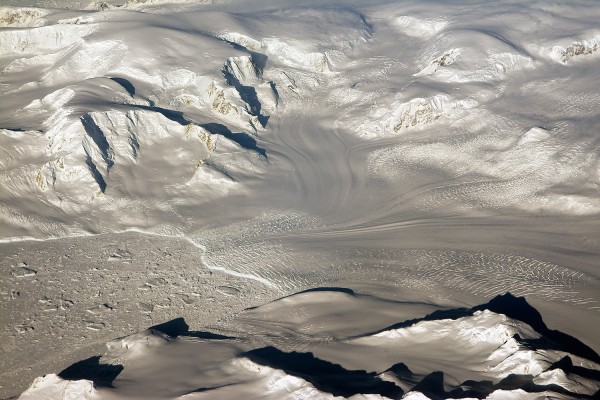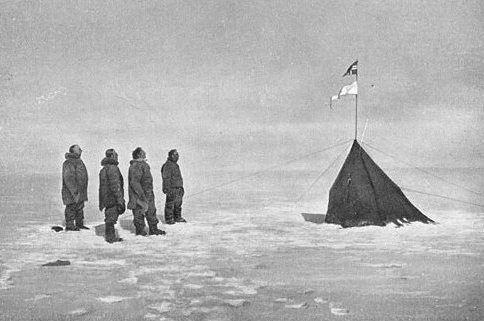
The melt rate of glaciers in the fastest-melting region of Antarctica has tripled during the last decade, according to a comprehensive, 21-year analysis that reconciles four different techniques previously used to measure Antarctic ice melting. The American Geophysical Union (AGU), which made the announcement on December 2, 2014, said the study is the first to evaluate and reconcile observations in this way. The new analysis shows that glaciers in the Amundsen Sea Embayment in West Antarctica (see map below) are melting faster than any other part of Antarctica. Scientists at the UC Irvine and NASA conducted the analysis, and the journal Geophysical Research Letters published their results.
Scientist Isabella Velicogna, part of the research team, said:
The mass loss of these glaciers is increasing at an amazing rate.
Scientist Tyler Sutterley, a doctoral candidate at UC Irvine, led the analysis. He said:
Previous studies had suggested that this region is starting to change very dramatically since the 1990s, and we wanted to see how all the different techniques compared. The remarkable agreement among the techniques gave us confidence that we are getting this right.
Read more from the AGU about the new study.

Will we look back at 2014 as a watershed year with respect to our knowledge of Earth’s southernmost, coldest continent? There’ve been major stories about Antarctica this year; for example, there was a story in May about what scientists called the unstoppable loss of six glaciers in West Antarctica. Also last May, scientists using satellite data announced that, overall, Antarctica’s land mass is losing 159 billion tons of ice to the sea every year.
At the same time, according to the National Snow and Ice Data Center in October, 2014, although Arctic sea ice continues low, Antarctic sea ice broke a record for the large size of its annual maximum extent this September. Antarctic sea ice quickly declined again, by the way, and by November 2014 was back to levels seen around this time last year.
What does it all mean? If the Antarctic continent is losing ice, shouldn’t we see sea ice around the Antarctic continent declining as well?
Apparently not. In September 2014, meteorologist Eric Holthaus at Slate wrote a great article offering several likely explanations as to why Antarctic sea ice grew so large in extent in 2014. Among other things, he said:
One theory says that warmer ocean waters are more effective at melting the tongues of Antarctic land ice glaciers that stick out into the sea. The resulting excess of freshwater raises the freezing point of the surrounding salt water, allowing more ice to form.
Another theory is that the winds that encircle Antarctica are growing stronger, in part due to the hole in the ozone layer, and pushing ice farther and farther away from the continent, allowing additional ice to take its place closer to Antarctica’s frozen shores. This theory is favored by the British Antarctic Survey, and a number of recent papers have backed it up.
A third theory is that since warmer air can hold more water vapor, it’s likely that there’s more rain and snow falling over the Southern Ocean. That too could decrease the ocean’s salinity near the surface, boosting sea ice levels.
You might want to read Holthaus’ article, which is the best I’ve seen on meteorological effects on Antarctic sea ice. On the subject of why Antarctic sea ice grew so large in extent this year, Holthaus concluded:
The reality is probably some combination of the above.
And that’s a way of saying the one thing that all of us who write about Earth science – and certainly every Earth scientist – know for certain.
That is, Earth’s climate is complicated. It’s full of butterfly effects and hard-to-predict feedback loops, causing Earth systems to follow paths, over time, that are hard to predict.

It’s only been through methodical and determined research over decades that the story of Antarcica – a harsh, cold and huge continent, with an area of 5.405 million square miles or 14 million square kilometers – has begun to unfold.
Remember that Antarctica has zero permanent residents. And remember that it was just over 100 years ago that Roald Amundsen’s team of explorers from Norway became the first to set foot at the South Pole (on December 14, 1911). That was five weeks ahead of a British team of explorers led by Robert Falcon Scott (Scott’s team all perished on the return journey).
Nowadays, scientists do go to Antarctica – primarily during the peak southern summertime months of December, January and February – but perhaps you’ll understand that on-the-ground measurements in Antarctica do not come easily.
Following those first footsteps at the South Pole in 1911, the earliest scientific surveys in Antarctica didn’t take place until the 1960s. By the 1970s, scientists had recognized that West Antarctic ice sheets rest on a bed grounded below sea level.
Another author of December 2014 study on the rate of ice melt tripling is scientist Eric Rigot. He wrote a popular article about Antarctica on May 17, 2014 in the Guardian, explaining that it wasn’t until the 1990s that scientists began to hone in on the details of ice sheet retreat in Antarctica, thanks to work by the British Antarctic Survey, NASA and Chile. The work showed that the warming ocean was affecting Antarctic glaciers and that the glaciers were thinning. From that point, speaking for the scientific community that studies Antarctic ice, Rigot wrote:
… we all sought to find out whether this was really happening. Now, two decades after this process started, we have witnessed glacier grounding lines retreat by kilometers every year, glaciers thinning by meters every year hundreds of kilometers inland, losing billions of tons of water annually, and speeding up several percent every year …
Think what you will about Antarctica, and about the scientists who dedicate a portion of each year to traveling there and working there. (Some, gasp, get grants!)
The fact remains that these scientists and their work – plus scientific analysis of satellite data – are all we have with respect to acquiring knowledge about Antarctica.
And, as the story has emerged, in the last decades of the 20th century and early years of this century, all signs from the Antarctic continent have pointed to melting, and more melting.
Bottom line: Melt rate in parts of Antarctica has tripled in the last decade, according to a comprehensive, 21-year analysis that reconciles four different previously used techniques. This post also mentions three meteorological theories about why Antarctic sea ice grew to a record extent in 2014. And it discusses the historic difficulty of obtaining information about Earth’s southern continent.











